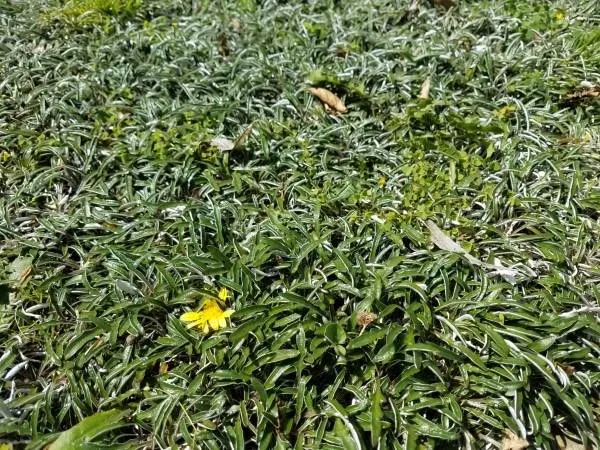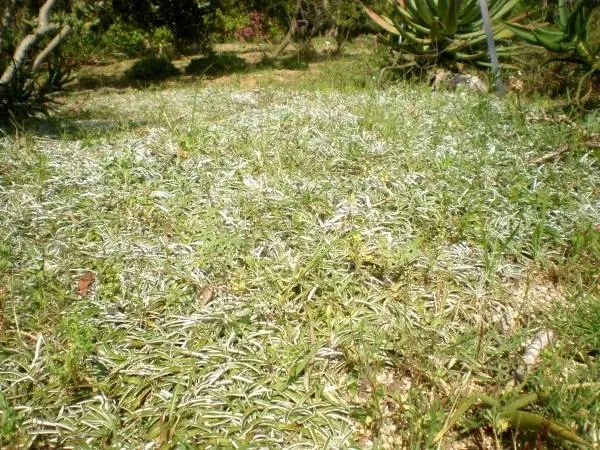Dymondia is also commonly referred to as a ‘silver carpet’ of its greyish-green leaves. Dymondia have white fuzz on their undersides which gives them a silver appearance. Due to its attractive, low maintenance, and hardy nature, Dymondia is widely grown as an alternative to grass. If you are worried about weeds, follow our tips to learn how to get rid of weeds in Dymondia.
Dymondia is perfect for warm and dry climates. Not only does it cover the ground with its charming leaves, but it also produces mesmerizing blooms that resemble daisies. Their flower attracts bees, and it is an environment-friendly plant. Keep following our guide to learn how to get rid of weeds in Dymondia.

How to Get Rid of Weeds in Dymondia?
Those pesky weeds growing in your garden are not only a nuisance, but they are also harming the growth of your plants. If you have a Dymondia lawn, chances are you are troubled by the weeds and don’t know what to do. If that’s the case, keep following the article to learn how to get rid of weeds in Dymondia.
Types of Weeds
Weed is any unwanted plant that might grow on your lawn. Several different weeds can invade your Dymondia, such as dandelions, crabgrass, clovers, etc. Below are some major categories of weeds commonly found in lawns and their identification.
- Broadleaf weed: Their leaves are flat and broad
- Example: dandelion, clover, ground ivy, dollar weed, henbit, thistle, plantain
- Grassy weed: Their leaves resemble the needle-like leaves of grass blades that grow individually.
- Example: crabgrass, foxtail, quack grass, annual bluegrass
- Grass-like weed: their leaves are quite similar to that of grass. However, they are not flat. The leaves are often tube-like, hollow, or triangular.
- Example: wild garlic, nutsedge, wild onion
4 Methods on How to Get Rid of Weeds In Dymondia
Here are 4 different methods which will teach you how to get rid of weeds in Dymondia and prevent them from growing back.
Items You Will Need
- Safety gloves
- Safety goggles
- Small pressure sprayer
- Broadleaf herbicide
- Crabgrass preventer
- Selective plant herbicide
- Tank sprayer
- Use high quality brass nozzle, strong, rust corrosion. The corrosion is one of the important factors influencing the durability and dependability of the sprayer.
- The handle has a locking mechanism, so you can easily one-handed operation.Save time and energy with more efficient tools.
- Adjustable brass nozzle, ergonomic locking handle and pressure release valve
- Use for plant, flower, garden and lawn care, pest control and auto wheels, windows and exterior body
- Sprayer comes with a hand-held pump that enables quick and easy pressurization of water. The addition of a non-slip handle makes it effortless to use.
- ✔️ PET & KID SAFE HERBICIDE - Eco Garden Pro Weed Killer is designed with you and your family in mind! All of our ingredients are carefully selected to be SAFE FOR: PETS, CHILDREN, BEES, FISH, AND ANY LIVESTOCK!
- ✔️ ORGANIC WEED KILLER - Formulated to KILL WEEDS AND GRASS FAST. Our proprietary formula will deliver IMMEDIATE RESULTS WITHIN 24 HOURS! Perfect for all residential, commercial, industrial, and agricultural use - including: driveways, sidewalks, concrete, mulch beds, pavement, flowers beds, parking lots, and farm lands.
- ✔️ WORKS within 24 HOURS POWERFUL PROPRIETARY FORMULATION - Our READY TO USE (RTU) formula contains natural white vinegar, organic rock salt, biodegradable plant activators, and fermentation derived co-factors, all designed to eliminate weeds and grass effectively and quickly.
- ✔️ WORKS FOR CLOVER, MOSS, & POISON IVY - Eco Garden Pro Weed Killer will work to eliminate all conventional weeds and grasses, including: DANDELIONS, CLOVER, CHICKWEED, DOLLAR WEED, THISTLE, CRABGRASS, MOSS, WHITE COVER, AND GENERAL WEEDS AND GRASSES.
- ✔️ GREEN LAWN FOR A GREEN ENVIRONMENT - Eco Garden Pro Weed Killer is designed to work effectively without any toxic chemicals. The product is ECO FRIENDLY, PHOSPHATE FREE, 100% BIODEGRADABLE, AND SAFE FOR GROUND WATER.
- Adjustable Nozzle: This sprayer comes with water column spray and shower spray settings, you can adjust the tightness of the nozzle to achieve different patterns; 22.28-in long wand and 50-in hose increase spraying radius
- Easy Operation and Safety: The ergonomic handle with locking trigger, you can drip or spray continuously by locking the handle or not; it has a safety valve setting that you can pull to release any built-up pressure
- Easy to Fill and Check: The large bowl and funnel design on the top makes it easy to fill; This pressure sprayer uses a translucent bottle with a calibrated scale, so you can easily check the liquid level
- Durable and Portable: The sprayer’s thickened bottom improves its durability and stability; Each sprayer comes with an adjustable heavy-duty shoulder strap that can be carried like a backpack or shortened to carry
- Multi-Functional: This pump sprayer can be used indoor and outdoor; Perfect for spraying plants, car cleaning, pet bathing, garden watering and household cleaning
1. Using a Selective Herbicide
One of the biggest mistakes often made by gardeners is the usage of non-selective herbicides. Using a non-selective herbicide kills your weeds and kills or damages your plants. To prevent that, you need to choose a selective herbicide that especially targets the unwanted plants, i.e., weeds, without damaging your actual plants.
Herbicides with the active ingredient 2-4D are suggested to be used as selective herbicides. 2-4D is the most common and widely used herbicide, which has proven to be very effective over the years of research.
This herbicide works by entering the targeted plant body and restricting its growth. That leads to the death of the weed. Using a small pressure sprayer is especially useful when targeting small spots or certain plants.
Just wear your gloves and goggles, and spray the herbicide on targeted spots of weeds as directed by the herbicide packaging. It starts working overnight and has an efficiency of about 99% at killing weeds such as broadleaves. You can go to your local hardware stores to easily buy such herbicides.
2. Pulling Out the Weeds by Hand
A much safer method is pulling the weed out by your hands or a trowel. If your weeds problem is not that severe and manageable, you can opt for this method. Wear gloves before you start because some weeds are prickly or even toxic and can cause itchiness or stings on your hands.
It is important to pull the weeds out with the roots. The roots will stay underground and grow again if you only pull the surface. You may use a screwdriver, a small shovel, a trowel, or any designated tool to pull out weeds.
If you tug the leaves, they will break, leaving the roots behind, in the ground. So before tugging, loosen the soil around the weed by digging a little. Then use a tool to pull the whole body of the weed out of the ground, including its roots. Any roots remaining in the ground will make the weeds grow again.
If you are pulling out dandelions, make sure you pull them while they are still yellow. Once they become white, they will start spreading the seeds even when gently moved. It will cause the weed to spread more; therefore, timing is important here.
3. Regular Mowing or Division
The Dymondia lawn does not need to be mowed like the regular grass. However, you can still trim it and divide it to control it. It will provide more aeration to the plant, reduce the clustering, and make it easier to spot a weed and kill it in time.
You will also be trimming the weeds, avoiding them from overgrowing whenever you are trimming and grooming your lawn. Do not let your Dymondia cluster or overgrow, as it may favor weed growth.
4. Re-sodding Your Lawn
If you have not been taking care of your Dymondia lawn for a long time, it is beyond repair. The weed would have taken over the whole space, and it will seriously affect the growth of your Dymondia. You may use some strong herbicide with a tank sprayer all over your garden. It will still deteriorate the quality of your lawn and make it look barren.
Your best bet is to trill the whole garden and start anew. It may seem harsh, but this is the final resort to the otherwise unmanageable weed infestation. It will give you a chance to start fresh plants which will grow healthy. Grooming and managing them would be easier, and you will have a much healthier-looking garden than ever before.

Dos and Don’ts of Killing Weeds
- Regularly check up on your garden, and don’t let the weeds grow out of your hands.
- Some people mistake using organic herbicides like vinegar, boiling water, gasoline, saltwater, etc. Never do any of that. It will affect your plants just as much as weeds and may render your soil barren for a long period.
- Aerate your garden regularly. Weeds like compact soil to grow into. Aeration will help get rid of weeds and also prevent them. It will also nurture your plants.
- Weeds prefer dry and hard soil. Aeration will also increase water retention of soil, thus, prohibiting the growth of weeds.
- Always use a selective type of herbicide while dealing with the weeds on the lawn. It will prevent your lawn from getting damaged.
Conclusion
There are two major reasons to get rid of weeds from your Dymondia lawn. First, it looks unattractive and brings down the whole look of the garden. Secondly, it affects your plant’s health, prohibits their growth, and makes them sick. You need to get the weeds out to keep your lawn looking spick and span and lush.
It can be challenging to get rid of weeds without damaging the plants. However, it is not entirely impossible. With our carefully enlisted methods and tips, you know how to get rid of weeds in Dymondia without damaging them. If you have any queries, share them in the comments.




Marybeth
Saturday 23rd of September 2023
I used a non selective herbicide to kill the grass which was a bermuda-fescue blend then sod cut it and dug it out. Waited a week or two to see what grew back. Nutsedge!!! We hand pulled as much as possible and I did apply 30% vinegar which helped. I did not plan on planting right easy so I was not concerned about affecting the soil PH. We planted Dymondia . Nutsedge still a problem. Can I used ORTHO Nutsedge Killer sprayed on top of Dymondia?
Hoang Quang
Sunday 24th of September 2023
@Marybeth,
I see that you are dealing with a persistent Nutsedge problem and have already taken several steps to address the issue, including using a non-selective herbicide, hand-pulling, and applying vinegar.
While these are great initial steps, Nutsedge is notoriously resistant to many common herbicides.
To address the remaining Nutsedge issue, you’re considering using Ortho Nutsedge Killer on top of the Dymondia.
Right?
According to Ortho, their Nutsedge Killer Ready-to-Spray product is effective against newly emerged and established sedges. So, it’s an excellent choice!
However, it’s important to note that Dymondia is not a grass but a groundcover plant. Therefore, DO NOT apply it directly on Dymondia, as it can cause harm to your desirable plant.
Moreover, it’s crucial to follow the product’s instructions carefully and apply it only as directed on the label.
Nutsedge can regrow from underground tubers, so it usually requires multiple herbicide applications. You can follow the product’s recommendations regarding repeated applications.
Lastly, you can consult the local gardening experts for the most up-to-date and region-specific recommendations.
I hope this helps!